Renault Duster cars are equipped with rack and pinion steering and power steering
The steering gear consists of two steering rods connected by ball joints to the levers of the steering knuckles of the front suspension
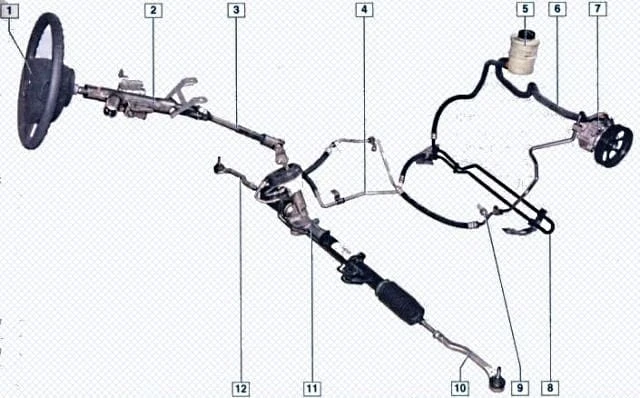
The steering mechanism is mounted on the front suspension subframe and secured to it with two bolts.
In the crankcase of the steering mechanism, the rack is pressed against the gear shaft by a spring through the stop.
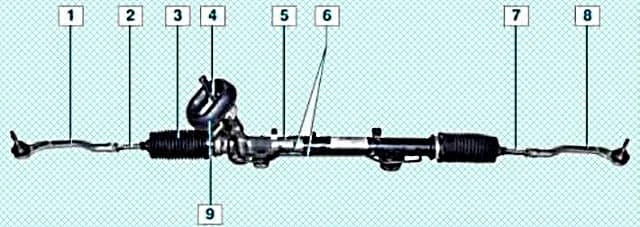
The side clearance between the gear and the rack is adjusted by rotating the adjusting plug, which compresses the spring.
Adjustment is carried out when assembling the steering mechanism at the factory.
The steering gear consists of two steering rods connected to the steering gear rack and steering knuckle levers.
Each rod is attached with its inner end to the steering rack through a non-separable ball joint - the threaded tip of the hinge is screwed into the hole in the rack.
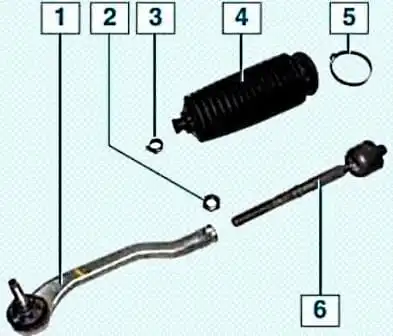
In the middle part of the steering rod there is a hexagon turnkey “13”, and on the outer end there is a thread onto which the rod end is screwed.
The tie rod end has a non-separable ball joint that does not require replenishment of the lubricant supply, which is embedded inside it for the entire service life.
The right and left tie rods are the same, but the ends are different.
The connection of the steering rack and the tie rod ball joint is protected from dirt and moisture by a corrugated rubber boot.
The cover is fixed with a steel disposable clamp on the steering gear housing, and the cover is held on the steering rod by a spring clamp - while the narrow belt of the cover must coincide with the groove made on the steering rod.
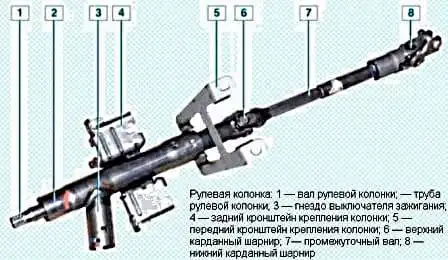
The steering column shaft is attached to the steering gear shaft through an intermediate shaft with two cardan joints.
A steering wheel is mounted on the splines in the upper part of the steering column shaft.
The steering column is attached to the cross member bracket located under the instrument panel.
The power steering system includes: a steering gear, a pump, a radiator for cooling the working fluid, a reservoir for working fluid and connecting pipes of the lines.
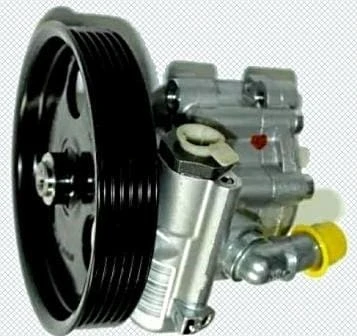
The pump is driven by a belt from the accessory drive pulley.
The hydraulic fluid from the reservoir enters the pump, and from it it is supplied under high pressure to the distribution device located in the steering gear housing anism and mechanically connected to the steering column shaft.
A hydraulic cylinder piston is fixed on the gear rack of the steering gear.
When the steering wheel is turned, the switchgear connects one of the hydraulic cylinder chambers to the pump discharge line, and the other chamber to the drain.
At the same time, due to the pressure difference of the working fluid, the hydraulic cylinder piston moves the rack to the left or right and through the steering rods, and the fist levers turn the steered wheels of the car.
A radiator is built into the hydraulic booster drain line to cool the working fluid.
The radiator is located behind the front bumper - mounted on the front suspension subframe in front of the air conditioning condenser and the radiator of the cooling system.
If the hydraulic booster fails, the ability to drive the car remains, but the force on the steering wheel increases.
The power steering reservoir is installed in the engine compartment - secured with a clamp to the radiator fan housing.
To control the liquid level, MIN and MAX marks are applied to the translucent body of the tank.
Possible Steering Malfunctions and Troubleshooting
- Cause of Malfunction - Troubleshooting
Excessive steering wheel play and knocking in the steering:
- - Loose steering gear mounting bolts - Tighten the bolts
- - Worn tie rod ball joints - Replace the joints
- - Worn steering shaft universal joint - Replace the steering shaft
Difficulty turning the steering wheel:
- - Slipping power steering pump drive belt - Replace the belt
- - Damaged pump drive belt - Replace the belt
- - Low working fluid level - Restore the level to normal
- - Air ingress in the hydraulic system - Bleed air
- - Kinked or damaged hoses - Eliminate kinking or replace hoses
- - Insufficient power steering pump pressure - Replace the pump
- - Increased internal leaks in the pump - Replace the pump
- - Fluid leaks from the steering gear - Replace defective components
Unclear return of the steering wheel to the center position:
- - Difficulty turning the inner joints or tie rod ends - Replace the tie rod ends
- - Deformation of the steering rack - Replace the steering gear
- - Damage to the pinion bearing - Replace the steering gear
- - Kinked or damaged power steering hoses - Eliminate kinking or Replace the hoses
- - Damaged pressure regulating valve - Replace the pressure regulating valve
- - Damaged pump rotor shaft bearing - Replace the pump
Noise (knocking) in the steering:
- Loose steering gear mounting bolts - Tighten the bolts
- Loose tie rods or tie rod end ball joints - Tighten the nuts
- Worn ball joints - Replace worn parts
Increased power steering pump noise:
- Low working fluid level - Restore the fluid level to normal
- Air entering the hydraulic system - Bleed the air
- Loose pump mounting bolts - Tighten the bolts.





